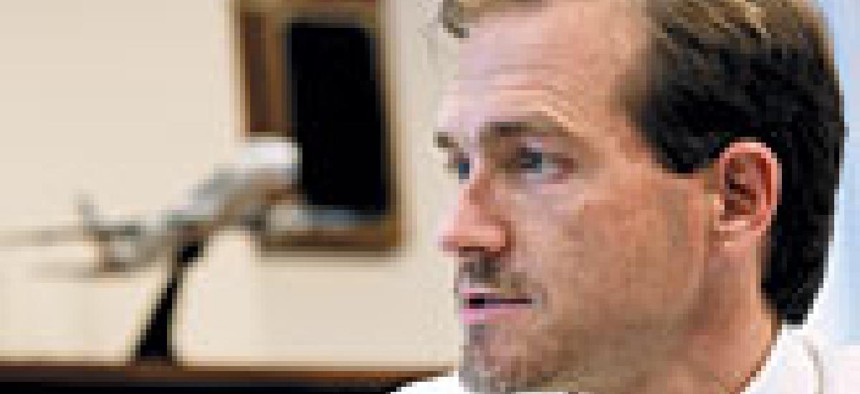Even though much of the focus on air travel has been directed toward airport security since Sept. 11, behind the scenes the Federal Aviation Administration has been reassigning priorities of the projects in its 10-year, $11.5 billion air traffic control modernization plan.Following a withering financial downturn in the airline industry, programs that require airlines to invest in new technology will wait in the takeoff queue until the industry bounces back, FAA officials said. But other parts of the modernization ernization plan are being accelerated.FAA's plan, dubbed the National Airspace System Operational Evolution Plan, tackles several problems: airplane arrival and departure rates, air traffic congestion, and severe weather en route to and at airports.When FAA released the plan in June, its objective was to boost airport capacity to handle a 30 percent increase in commercial flights, reduce delays and give pilots greater freedom in choosing efficient flight paths.The plan comprises more than 100 projects that FAA hopes to put into operation over the next 10 years. Many require investment by the airline industry.'We are rearranging them to see where we can accelerate things and where we should decelerate,' said Charles E. Keegan, FAA's modernization leader.Keegan is working on a revision of the plan, which he said will be released by the end of this month.The revision will decelerate projects that require 'some kind of synchronized investment between the industry and the government,' Keegan said.But Michael Goldfarb, former FAA chief of staff and now an aviation consultant, is skeptical that industry investment can be delayed without a significant impact on the modernization effort.'All programs that are crucial to FAA modernization require the active participation of the industry, whether it's better surveillance, better satellite navigation and better flight paths,' he said. 'No participation from the industry would amount to forestalling the modernization.'I question the ability of the government in carrying the modernization by itself,' Goldfarb added.One project that FAA will delay is the controller pilot data link communications system (CPDLC), which would require airlines to invest in new radio equipment.The air traffic control system relies heavily on voice communication between controllers and pilots to coordinate aircraft movement and transmit advisories, clearances and weather data.But as air traffic has increased, controller-pilot communication has saturated the airwaves during peak traffic periods, which can interfere with the communication of other pilots and controllers.CPDLC would let air traffic controllers and flight crews exchange e-mail instead of voice messages. It would divert routine exchanges to a data channel, freeing the voice channel for time-critical communications such as weather and traffic updates.FAA had planned to deliver CPDLC nationwide by 2005 as part of its Free Flight Phase 2 program. Computer Sciences Corp. won a $53 million contract to develop and implement the system.'We'll probably defer that by 18 months to two years and work with the airlines to re-establish an appropriate time to come out with that program,' Keegan said.FAA will test CPDLC at its Miami center in June but will defer national deployment until airlines can make an investment.Ray Bjorklund, vice president of Federal Sources Inc., a McLean, Va., consulting firm, said financial troubles are dogging the airline industry.'For the airline industry to make investments now is a bit of a stretch,' he said. 'It makes sense that FAA is making changes in its plan to not cause so much of an impact on the industry.'Other projects are being accelerated. A case in point is the $200 million user request evaluation tool, which is being built by Lockheed Martin Corp.URET software gives controllers a 20-minute advance look at air traffic to detect potential conflicts and assess pilots' requests for altitude and route changes.It can map out alternate routes and create a graphic display of plans, problems and future traffic patterns.FAA originally planned to deploy URET in Atlanta, Chicago, Cleveland, Indianapolis, Kansas City, Mo., Memphis, Tenn., and Washington by 2002, and install it in another 10 centers over the next 10 years. But the agency has compressed that schedule in order to take advantage of its benefits sooner.'Post-Sept. 11, we will aggressively pursue and get all the 20 centers fitted with the tool as quickly as possible,' Keegan said. 'That's one of the things that we accelerate because it provides us with about 2,500 more direct routes for aircraft every single day.'The administration is also pushing forward programs such as Free Flight's surface movement adviser and traffic movement adviser, which are managed by FAA and do not require investment from the airlines.The surface movement adviser provides aircraft arrival information to airlines and airport employees who plan and manage traffic flow on airline ramps.The traffic management adviser helps workers make speedy decisions during heavy air traffic.FAA's Free Flight Phase 1 program implements a gradual modernization schedule at major airports across the country and is on its original, pre-Sept. 11 track. With the December deployment of URET in Kansas City, the program will wind down, and Free Flight Phase 2 will take off.'From a planning perspective, we are right on track with Free Flight Phase 2,' Keegan said. 'In March, we expect to gain the entire agency approval for the specific times, dates, plans and locations.'Keegan stressed that increasing commercial flights by 30 percent remains one of FAA's major priorities in modernization, despite the airline downturn resulting from Sept. 11.The National Air Traffic Controllers Association, which represents 15,000 air traffic controllers and 1,200 FAA engineers, warily agrees that capacity enhancement should remain a top priority even though the economic downturn has reduced air traffic and congestion.'We need to take this opportunity to get ahead of the curve and recognize that soon we will have the same capacity problems that we were facing pre-Sept. 11,' said Ruth Marlin, NATCA executive vice president.
Charles E. Keegan says FAA will accelerate some projects but wait on those that require the troubled airline industry to invest.
FAA modernization chief Charles E. Keegan says some projects managed by FAA, such as the Free Flight program to help streamline airport operations, are on schedule.








